Industriel & Cultural Tours
• KIA Factory in Gwangju
 |
The factory was established in 1965 but was handed over to Hyundai Motors in 1998. The factory has produced popular sports utility vehicles, trucks, military vehicles, special vehicles. A total of 420,000 cars are produced yearly and 6,700 employees work at the factory. The Kia factory is occupied with 24% of total productions, 22% of employment and 120,000 m2 in Gwangju. www.kia.co.kr |
• Kumho Tire History Center
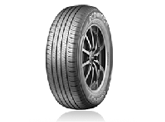 |
Kumho Tires is the first company in the industry to open a tire history center. Located on the first floor of the Kumho Tire factory in Gwangju, the center is 860㎡ and is titled “Traces of Wheels.” Six exhibit halls will show you about the history of tires.
www.kumhotire.co.kr |
• Gwangju Technopark
 |
Gwangju Technopark was established in 1999, in the Korean finance crisis, as a enterprise support institution through the joint of the Korean govornment, Gwangju Metropolitan and local university to aim at promoting regional economy developments. Gwangju Technopark is on the center of the mecca for the development of future strategic industry and the success of high-tech industry. |
• Mt. Mudeung
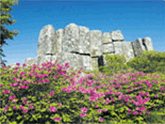 |
Mt. Mudeung is a representative symbol of Gwangju, which contains the ideologies of Namdo people. Pink and royal azaleas in Spring, red leaves and purple eulalia in Autumn, snow flower in Winter are the best charms of Mt. Mudeung. You can look down over Gwangju city at a glance. |
• Wonhyosa Temple
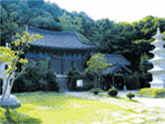 |
Wonhyosa is located at northern border of the mountain and built by Wonhyo-daesa who was national monk of Silla. Wonhyo-am, previous name of Wonhyosa was named after its founder. Some 100 Buddhist relics including a standing bronze Buddha sculpture were discovered under the construction of new buildings in 1980, and they are exhibited at Gwangju Museum. |
• Gwangju Culture and Art Center
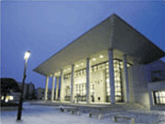 |
Mecca of performing art is the best cultural space in south western Korea with world-class facilities. The large theater is facilitated with a spacious stage, a rehearsal hall, make-up rooms, seating for 1800 people, and high-tech lights and sound. It gives various performances like operas, ballets, and modern dances to local art-lovers throughout the year. The little theater seats about 500 people. |
• Gwangju National Museum
 |
It is a traditional style building that opened in 1978. It has prehistoric relics, Okwan tomb of Youngsan valley, old torn relics, Buddihist art craftwork, and ceramics from the unified Silla and Goryeo period. Furthermore, it has paintings of Chosun and relics from Song whose ship sank to the bottom of the sea. |
| Gwangju is renowned as the home of Korean food, taking pride of the excellent cuisine and unforgettable flavor through a long history in Korea. The western south region of Korea grows up plenty of vegetables, fruits, rice and fishes. Especially, Gwangju Kimchi is famous for the taste, by using the fresh and plentiful ingredients. Every year since 1994 Gwangju Kimchi Festival has been opened and now developed as World Kimchi Festival, which takes the initiative role of telling the excellence of Gwangju Kimchi domestically and also to the world and growing the Kimchi industry. |
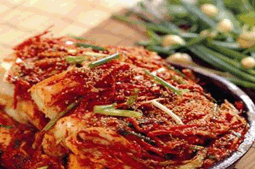 |
• Hanjeongsik (Traditional Korean full set menu)
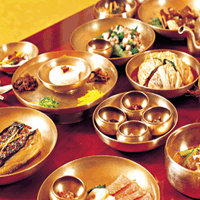 |
Typical Korean meals named “Hanjeongshik” are served with rice, soup and side dishes. The numbers of side dishes (banchan) accompany the Kimchi, vegetables, tofu, fish, and meat. The types and number of banchans may vary by restaurants but the servings are always ample. The Korean meals can be served for vegetarians. |
• Bo-ssam (Steamed Pork Wrapped in Leaves)
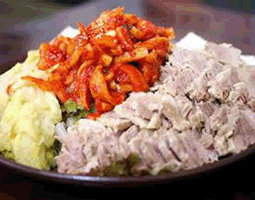 |
Bossam is a type of wrapped food in Korean cuisine in which steamed pork is wrapped in a leaf vegetable such as red lettuce or sesame leaf, often accompanied by a condiment known as ssamjang. It is usually topped with raw or cooked garlic, onion, pepper, or, most commonly, sweet Kimchi. Bossam is also preferred to be eaten with saeujeot (pickled fermented shrimp). It's a popular dish in Korea and it can also be served as an anju (side dish consumed while drinking soju). |
• Dduk Gal-bi (Grilled Pork Ribs)
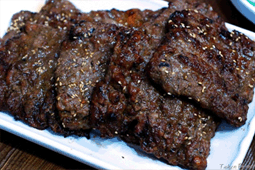 |
Dduk Galbi is Korea's finest grilled spareribs (pork) that are succulent in taste as well as appealing to the eyes. Duck Galbi is much close to barbecued, L.A. style, galbi ribs which are crisply grilled to perfection with its tenderloins and bones still attached. However, Dduk galbi tends to be quite spicy in taste as gochujang (red chili pepper paste) is added to the base of this marinade sauce. |













